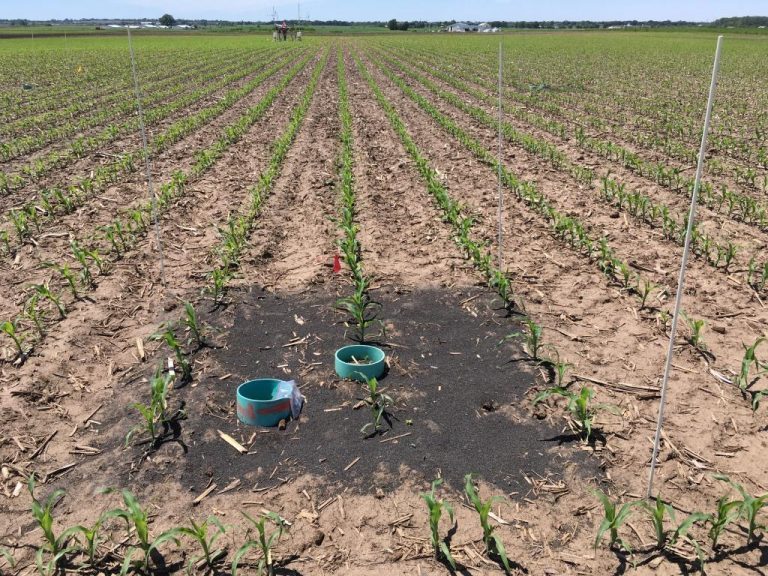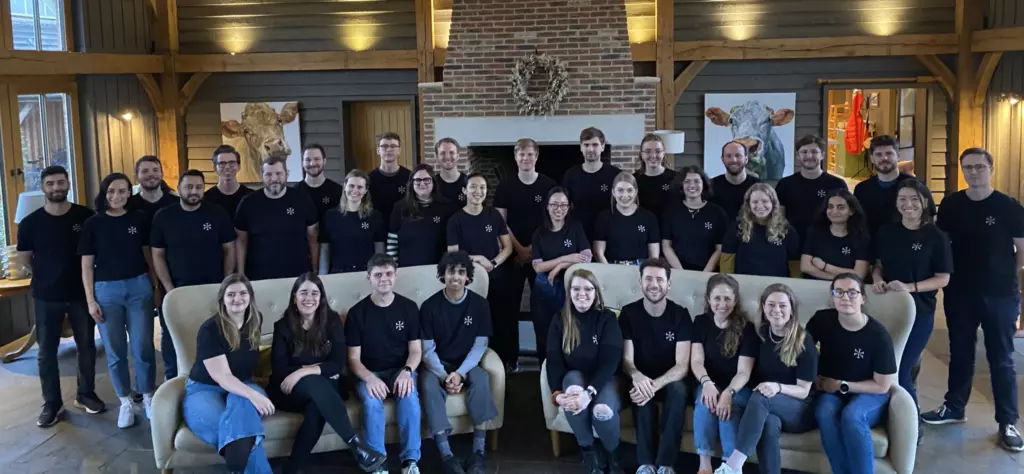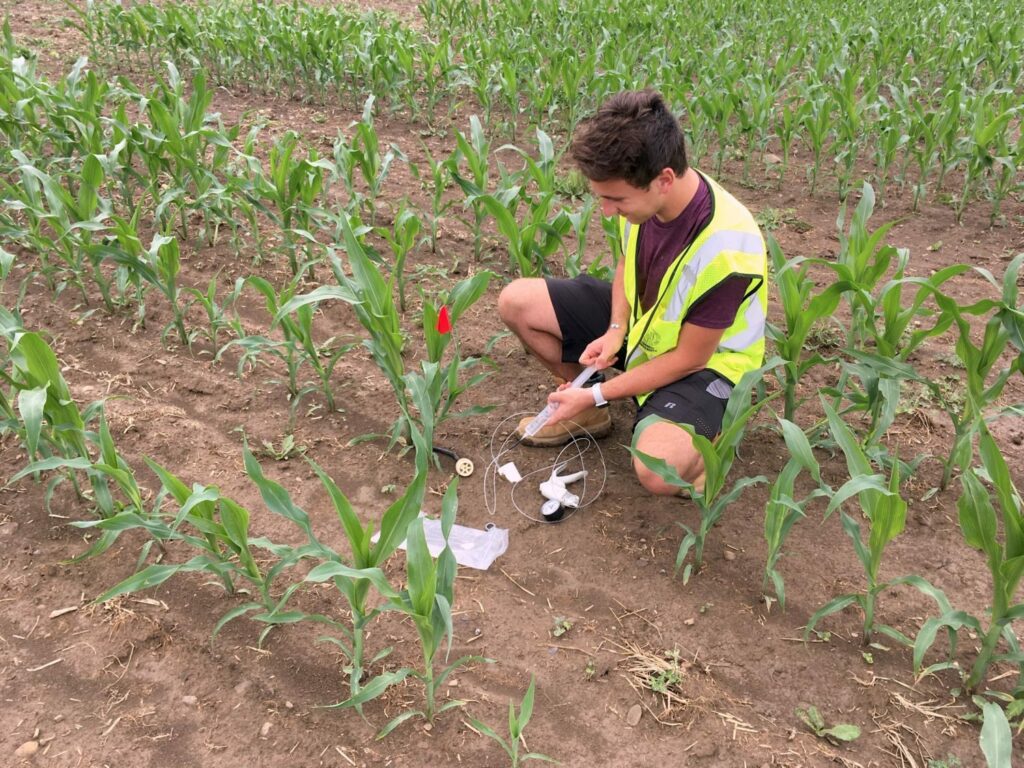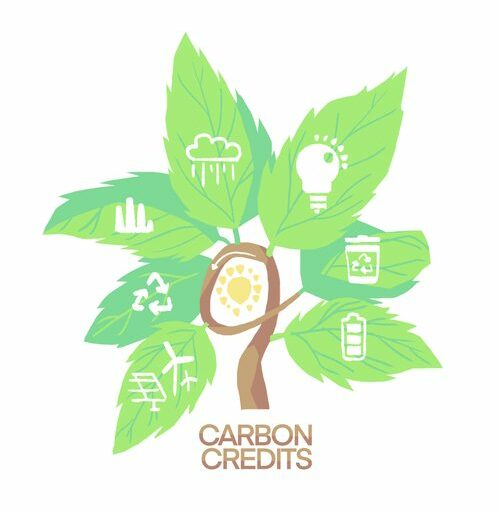New Isometric Protocol for Carbon Dioxide Removal Via Rock Dust Weathering
Cornell researcher sampling pore waters from soils treated with rock dust as part of an enhanced weathering field experiment (photo credit: Garrett Boudinot, Sophie Nasrallah, extracted from Yale Environment 360)
The carbon-tech company Isometric has released a new protocol. It provides science-based guidelines for monitoring, reporting, and verifying carbon dioxide removal via rock dust weathering. This state-of-the-art Enhanced Rock Weathering Protocol is based on the rigorous Isometric Standard and incorporates the latest scientific findings from field and laboratory/greenhouse experiments. Isometric’s work in this area could boost the credibility of carbon offset markets, which have seen a drop in demand over the past year due to a lack of transparency. The Enhanced Rock Weathering Protocol is a great step forward towards scaling up agriculture-based carbon removal. But it remains to be seen if carbon markets help or hinder the fight against climate change.
Carbon Markets Struggling With Credibility
Over the past 35 years or so, global marketplaces or trading systems have developed around the buying, selling, and trading of so-called carbon credits. A carbon credit is a quantitative offset. It’s based on carbon emissions reductions or removal performed by an emissions abatement or carbon dioxide removal project (one carbon credit usually corresponds to one metric ton of carbon dioxide removed from the atmosphere). Companies buy these quantitative credits to offset their emissions. This can allow them to reach net zero or carbon-neutral targets without entirely eliminating carbon emissions from their operations.
Proponents of carbon markets argue that they provide the free-market source of climate finance that incentivizes innovations in clean energy, emissions reductions, and carbon dioxide removal. However, critics say that the voluntary carbon markets have led to the production (and trading) of artificial or phantom offsets. This has led to erroneous emissions reduction claims. In this way, voluntary carbon markets can become “elaborate greenwashing mechanisms” (Dawes, 2024).
Allegra Dawes, writing for the Center for Strategic and International Studies, highlights other credibility and transparency issues with the carbon markets. For example, an investigative report by The Guardian, Die Zeit, and SourceMaterial found that more than 90 percent of forestry credits from one of the world’s leading certifiers did not represent real emissions reductions. This and other recent questions about the validity of some carbon offsets have led to a significant credibility problem for carbon markets as a whole. This credibility issue has the potential to derail the markets as companies become wary of reputational risks associated with investing in potentially fictional carbon offsets.
Two of the trickiest aspects of generating and verifying carbon credits are “additionality” and “permanence.” Additionality guarantees that the carbon sequestration represented by a given carbon credit would not have happened without the financial incentive provided by the carbon market. While permanence (or durability) refers to how long the carbon sequestered by a given process remains out of the atmosphere (e.g., how much time passes between carbon sequestration and re-emission). Additionality and permeance are notoriously difficult to quantify and verify for some carbon sequestration and emissions reduction projects.
These issues led to some major questions about the credibility of carbon credit offsets and their markets. And companies seem to be taking notice. In 2023, voluntary carbon markets shrunk for the first time in at least seven years. Data shows that this decrease was primarily associated with decreased offset buying from large corporations such as Nestle and Gucci (Reuters). Nestle representatives have reported that the company will no longer use carbon offsets to achieve net zero emissions. Instead, they will invest in programs and practices that reduce carbon emissions from their supply chain and operations (Reuters).
The failure or devaluation of carbon markets, however, could be a significant setback for generating financial incentives for climate action. As Dawes points out:
The past year showed that companies are increasingly wary of the potential pitfalls that result from claims that are not backed up by credible emissions reductions. Despite this, voluntary markets can be a useful tool to combat climate change and accelerate the energy transition. A global price on carbon is unlikely to emerge any time soon, but there is a real desire from many companies to reduce emissions and reach net zero.
The heart of the issue is ensuring that “carbon credits represent real, additional, and permanent emissions reductions” and carbon dioxide removals (Dawes, 2024).
Improving Carbon Dioxide Removal Credibility: Enhanced Weathering
One of the most rapidly expanding parts of the carbon market is the demand for credits based on carbon dioxide removal (CDR). In their 2022 report “Mitigation of Climate Change” (WGIII), the UN Intergovernmental Panel on Climate Change (IPCC) concluded that CDR would be indispensable in humanity’s efforts to avoid potentially catastrophic global warming. Recently, there has been a major surge in interest in the natural/agricultural CDR method referred to as Enhanced Rock Weathering (ERW) or enhanced rock weathering (ERW). This process involves applying finely ground, natural rock material (e.g., waste materials from mines) to agricultural fields. Under certain conditions, the mineral grains within the rock dust dissolve or weather, thus releasing their constituent elements into the soil. Many of the elements released from rock dust are essential nutrients for plants and the soil microorganisms that maintain beneficial soil conditions and help crops grow. For example, the common volcanic rock basalt is an excellent source of the essential nutrients magnesium, calcium, and phosphorus and also contains a wealth of trace nutrients that improve crop health, resilience, and nutrient density.

The added nutrients from rock dust can increase plant growth and accentuate the accumulation of organic carbon in the soil. Enhanced rock weathering also removes carbon dioxide from the atmosphere by converting it into geologically stable forms of carbon called carbonates. This carbon trapping process occurs as carbon dioxide in the soil pores reacts with the positively charged elements released from rock dust during weathering (e.g., magnesium and calcium).
Numerous climate tech companies have sprung up around the world, employing ERW to generate and sell carbon offsets (for example, see this RTE blog post, “Crash Course on Enhanced Rock Weathering for Carbon Removal”). However, questions remain about the additionality and permanence of the carbon dioxide removed through rock dust weathering. The credibility of carbon offsets generated by ERW depends on whether or not the amount of carbon supposedly removed by the process can be quantitatively verified. While this issue remains a subject of ongoing research, recent innovations in verification protocols are pointing in a positive direction.
The Isometric Enhanced Weathering Protocol
Isometric is a climate-tech company based in London and New York founded in 2022 to ensure the fast and responsible deployment and upscaling of carbon dioxide removal. They are a CDR registry devoted to building trust in carbon removal. Isometric claims that “CDR gives society an opportunity to build a new kind of carbon market: one where actions are verifiably additional and durable.” As a registry, they record verified carbon credits that satisfy their scientifically rigorous Isometric Standard. The Standard provides requirements ensuring that all carbon credits in the Isometric Registry have “measurable climate impact.” The Standard has specific requirements for durability (i.e., permanence) and additionality backed by state-of-the-art scientific techniques and uncertainty quantification (Isometric Standard).
Based on this rigorous Standard, Isometric recently developed and released an Enhanced Weathering Protocol. The protocol, which is currently available for public consultation, provides the latest science-based methods and techniques for monitoring, reporting, and verifying carbon dioxide removal from enhanced weathering projects. Although relatively new, the protocol has already received endorsements from ERW practitioners. For example, Dr. Matthew Clarkson, Head of Carbon at InPlanet (a company applying rock dust weathering in tropical soils), gives the following review:
“Isometric’s protocol represents a leap forward in creating clarity for both ERW operators and CDR buyers. It combines crucial elements of the best available science with pragmatic approaches to operationalize methods and decrease future costs. Moreover, it recognises the importance of learning in early applications and creates clear expectations for credit verification.”
One of the key innovations in the Isometric ERW Protocol is the emphasis on direct measurements of mineral weathering and carbonate-based carbon storage. In contrast, other protocols emphasize computer modeling and simulations that may have high uncertainties and are notoriously difficult to verify. Isometric’s approach provides detailed guidance on required field measurements. The resulting ground-truth data quantify the amount of CO2 converted to carbonate (i.e., carbon trapped in the soil and groundwater in non-gaseous forms).
As stated in the protocol summary, the Isometric approach ensures “consistent, accurate procedures are used to measure and monitor all aspects of the process required to enable accurate accounting of net CO2e removals” and that “consistent system boundaries and calculations are utilized to quantify net CO2e removal for agricultural ERW projects” and “evidence is provided and verified by independent third parties to support all net CO2e removal claims.”
The Isometric ERW Protocol is based on the latest scientific results from field and laboratory/greenhouse studies of rock dust weathering in agricultural soils. However, due to the relatively limited number of large-scale ERW field studies, the protocol’s requirements for field measurements are more stringent than other CDR regulations. In future versions, these requirements may be amended as more reliable field-based datasets on ERW carbon capture permanence and rock powder weathering rates become available in the open scientific literature.

The protocol also promulgates specific requirements regarding environmental and social safety hazards of rock dust applications. Environmental impact mitigation strategies and water resource management plans are covered, as well as community health and safety considerations. Another critical community safeguard addressed in the protocol is agricultural impact. To this end, enhanced weathering project operators are required to monitor crop productivity and soil health.
As stated in the protocol: “Maintaining crop productivity is critical to the environmental and social sustainability of ERW projects.”
In addition, the ERW project operator must implement soil management practices to maintain or enrich soil quality. The operator must provide technical support, training, and resources that help farmers adapt to new soil conditions resulting from rock dust applications. The specifics of this technical support are farm-specific but will generally include advice on crop selection, additional soil amendments, and sustainable farming practices.
Conclusion
These are uncertain times for carbon markets and carbon finance. It’s unclear if some of the latest carbon dioxide removal methods, such as enhanced weathering, will have the staying power to impact global carbon emissions and removal goals. However, the Isometric Standard and their new Enhanced Weathering Protocol are steps in the right direction. The protocol will facilitate the production of rigorously verified, science-backed carbon offset credits that are verifiably additional and durable. This thorough, scientific approach has the potential to restore some credibility to beleaguered carbon markets. However, the jury is still out on whether these markets represent a helpful incentive or a harmful distraction to climate change mitigation efforts.
James Jerden is an environmental scientist and science writer focused on researching and promoting sustainable solutions to urgent environmental problems. He holds a Ph.D. in geochemistry from Virginia Tech and a Master’s degree in geology from Boston College. Over the past 20 years, James has worked as a research geochemist and science educator. He joined Remineralize the Earth because of their effective advocacy, research, and partnership projects that support sustainable solutions to urgent environmental issues such as soil degradation (food security), water pollution from chemical fertilizers (water security), deforestation, and climate change. As a science writer for RTE, his goal is to bring the science and promise of soil remineralization to a broad, non-technical audience. When not writing, he can be found at his drum set
Support us on Patreon
Thank you for joining us today! Please become a member of RTE and support us on Patreon. Unlike many larger organizations, we work with a team of determined and passionate volunteers to get our message out. We aim to continue to increase the awareness of remineralization to initiate projects across the globe that remineralize soils, grow nutrient dense food, regenerate our forests’ and stabilize the climate – with your help! If you can, please support us on a monthly basis from just $2, rest assured that you are making a big impact every single month in support of our mission. Thank you!










Got something to say?